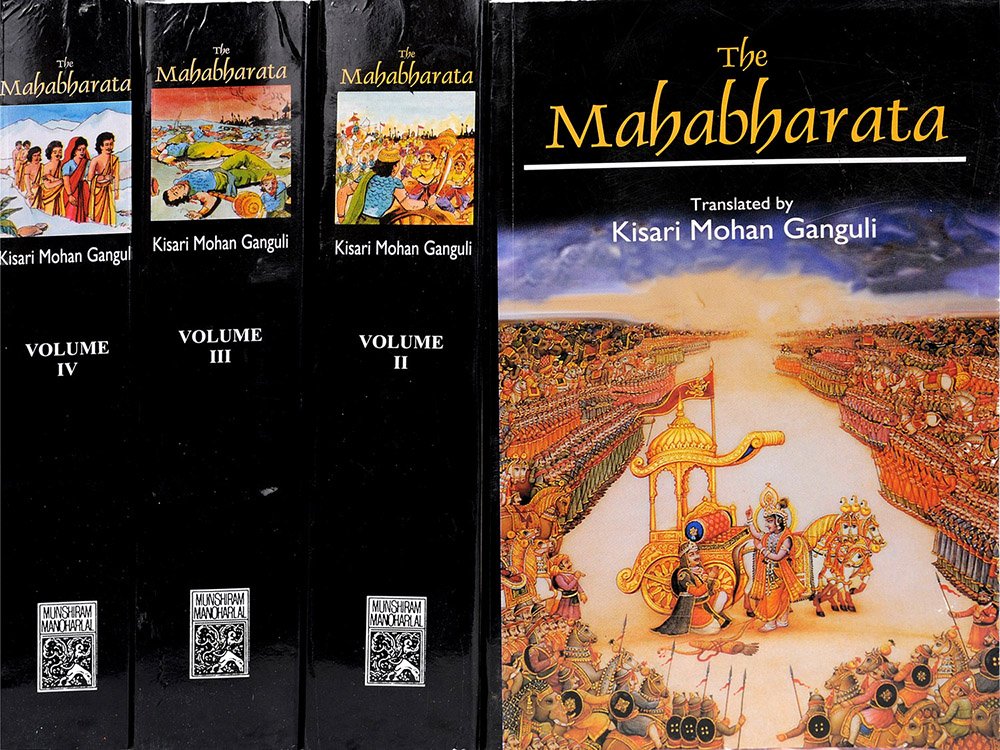Mahabharata (English)
by Kisari Mohan Ganguli | 2,566,952 words | ISBN-10: 8121505933
The English translation of the Mahabharata is a large text describing ancient India. It is authored by Krishna-Dwaipayana Vyasa and contains the records of ancient humans. Also, it documents the fate of the Kauravas and the Pandavas family. Another part of the large contents, deal with many philosophical dialogues such as the goals of life. Book...
Section V
"Dhritarashtra said,—
'The names of rivers and mountains, O Sanjaya, as also of provinces, and all other things resting on the earth, and their dimensions, O you that are acquainted with the measures of things of the earth in its entirety and the forests, O Sanjaya, recount to me in detail.'
"Sanjaya said,—
'O great king, all things in the universe, in consequence of the presence (in them) of the five elements, have been said to be equal by the wise. These elements, are space, air, fire, water, and earth. Their (respective) attributes are sound, touch, vision, taste, and scent. Every one of these elements possesses (in addition to what is especially its own) the attribute or attributes of that or those coming before it. The earth, therefore, is the foremost of them all, possessing as it does the attributes of all the other four, besides what is specially its own, as said by Rishis acquainted with truth.[1]
There are four attributes, O king, in water. Scent does not exist in it. Fire has three attributes viz., sound, touch, and vision. Sound and touch belong to air, while space has sound alone. These five attributes, O king, exist (in this way) in the five principal elements depending on which all creatures in the universe exist. They exist separately and independently when there is homogeneity in the universe.[2] When, however, these do not exist in their natural state but with one another, then creatures spring into life, furnished with bodies. This is never otherwise.
The elements are destroyed, in the order of the one succeeding, merging into the one that proceeds; and they spring also into existence, one arising from the one before it.[3] All of these are immeasurable, their forms being Brahma itself. In the universe are seen creatures consisting of the five elements. Men endeavour to ascertain their proportions by exercising their reason. Those matters, however, that are inconceivable, should never be sought to be solved by reason. That which is above (human) nature is an indication of the inconceivable.
"'O son of Kuru’s race, I will, however, describe to you the island called Sudarsana. This island, O king, is circular and of the form of a wheel. It is covered with rivers and other pieces of water and with mountains looking like masses of clouds, and with cities and many delightful provinces. It is also full of trees furnished with flowers and fruits, and with crops of diverse kinds and other wealth. And it is surrounded on all sides with the salt ocean. As a person can see his own face in a mirror, even so is the island called Sudarsana seen in the lunar disc. Two of its parts seem to be a peepul tree, while two others look like a large hare. It is surrounded on all sides with an assemblage of every kind of deciduous plants. Besides these portions, the rest is all water. What remains I will describe to you shortly. The rest I will speak of afterwards. Listen now to this that I describe in brief.[4]"
Footnotes and references:
[1]:
I have rendered 4 and 5 a little too freely. The language of the original is very terse.
[2]:
Samyam is homogeneity. The allusion is to the state of the universe before creation, when there exists nothing but a homogeneous mass or Brahma alone. The first compound of the 2nd line is read differently. The Burdwan Pandits and the Bombay edition read anyonyam (in the accusative); many of the Bengal texts read anyonyena (in the instrumental). The meaning is scarcely affected by this difference of reading.
[3]:
The order of destruction is that earth merges into water, water into fire, fire into air, and air into space. And so the order of birth is that from space arises air, from air arises fire, from fire arises water, and from water arises earth.
[4]:
Nilakantha explains the last six slokas as having an esoteric meaning. By Sudarsana he understands the mind. The rest is explained consistently. Interpretations, however, are not rare among commentators seeking to put sense in non-sense.
Conclusion:
This concludes Section V of Book 6 (Bhishma Parva) of the Mahabharata, of which an English translation is presented on this page. This book is famous as one of the Itihasa, similair in content to the eighteen Puranas. Book 6 is one of the eighteen books comprising roughly 100,000 Sanskrit metrical verses.
FAQ (frequently asked questions):
Which keywords occur in Section V of Book 6 of the Mahabharata?
The most relevant definitions are: Sanjaya, Sudarsana, Dhritarashtra, Rishis, Brahma, Kuru; since these occur the most in Book 6, Section V. There are a total of 6 unique keywords found in this section mentioned 9 times.
What is the name of the Parva containing Section V of Book 6?
Section V is part of the Jambukhanda Nirmana Parva which itself is a sub-section of Book 6 (Bhishma Parva). The Jambukhanda Nirmana Parva contains a total of 10 sections while Book 6 contains a total of 3 such Parvas.
Can I buy a print edition of Section V as contained in Book 6?
Yes! The print edition of the Mahabharata contains the English translation of Section V of Book 6 and can be bought on the main page. The author is Kisari Mohan Ganguli and the latest edition (including Section V) is from 2012.
